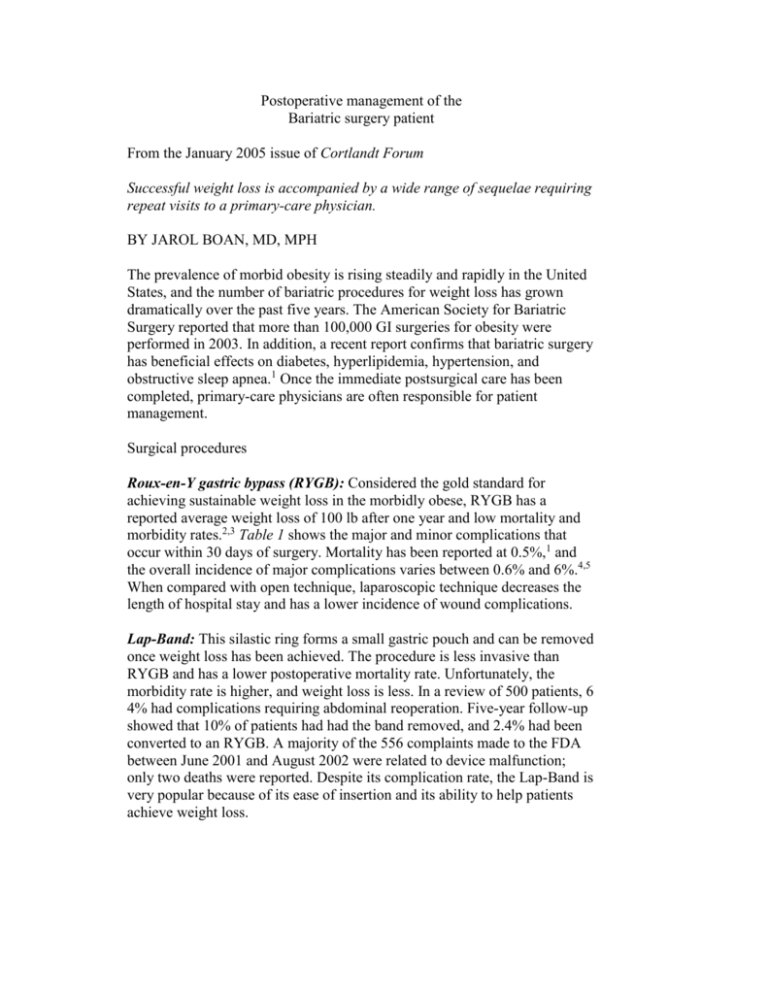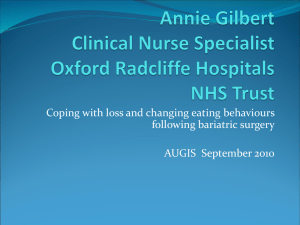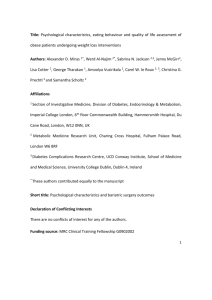Post-Op Bariatric Surgery Patients
advertisement

Postoperative management of the Bariatric surgery patient From the January 2005 issue of Cortlandt Forum Successful weight loss is accompanied by a wide range of sequelae requiring repeat visits to a primary-care physician. BY JAROL BOAN, MD, MPH The prevalence of morbid obesity is rising steadily and rapidly in the United States, and the number of bariatric procedures for weight loss has grown dramatically over the past five years. The American Society for Bariatric Surgery reported that more than 100,000 GI surgeries for obesity were performed in 2003. In addition, a recent report confirms that bariatric surgery has beneficial effects on diabetes, hyperlipidemia, hypertension, and obstructive sleep apnea.1 Once the immediate postsurgical care has been completed, primary-care physicians are often responsible for patient management. Surgical procedures Roux-en-Y gastric bypass (RYGB): Considered the gold standard for achieving sustainable weight loss in the morbidly obese, RYGB has a reported average weight loss of 100 lb after one year and low mortality and morbidity rates.2,3 Table 1 shows the major and minor complications that occur within 30 days of surgery. Mortality has been reported at 0.5%,1 and the overall incidence of major complications varies between 0.6% and 6%.4,5 When compared with open technique, laparoscopic technique decreases the length of hospital stay and has a lower incidence of wound complications. Lap-Band: This silastic ring forms a small gastric pouch and can be removed once weight loss has been achieved. The procedure is less invasive than RYGB and has a lower postoperative mortality rate. Unfortunately, the morbidity rate is higher, and weight loss is less. In a review of 500 patients, 6 4% had complications requiring abdominal reoperation. Five-year follow-up showed that 10% of patients had had the band removed, and 2.4% had been converted to an RYGB. A majority of the 556 complaints made to the FDA between June 2001 and August 2002 were related to device malfunction; only two deaths were reported. Despite its complication rate, the Lap-Band is very popular because of its ease of insertion and its ability to help patients achieve weight loss. Phase 1 complications (1-6 weeks post-op) Many postoperative complications are handled by the surgeon involved. These include bleeding, staple-line leak, bowel perforation, bowel obstruction, severe wound infections, minor wound infections, pulmonary embolism, peri-operative MI, pneumonia, and UTI. Physical effects: During the immediate perioperative period, obesity-related medical comorbidities change dramatically. Because it often drops into the normal range without medications, BP should be monitored at all postoperative visits. The possible need for reinstituting antihypertensive medications requires regular evaluation. Hypotension is also common, especially if there is poor fluid intake or persistent vomiting. Routine antireflux medications should be discontinued unless symptoms persist after surgery. Diabetes patients require frequent monitoring. The need for insulin often decreases, and a sliding scale for subcutaneous insulin injections should be provided. In those whose diabetes was previously managed with oral medications, such as sulfonylureas or thiazolidinediones, there is an increased risk of hypoglycemia. The biguanide metformin is the safest drug in the postoperative period because it is not associated with dramatic fluctuations in blood glucose. The decreased need for antidiabetic therapy is likely due to an average intake ranging from only 400-800 kcal/day for the first month; this is associated with rapid weight loss (20-40 lb) and a resulting decreased need for insulin. Moreover, anatomic changes after RYGB may result in alterations in insulin signaling. Discontinuation of diabetic medications should be considered when blood glucose normalizes and the patient is eating. Psychological sequelae: Patients on antidepressants and other psychotropic medications should continue these agents in the immediate postoperative period because the dramatic weight loss that occurs in the first few months postsurgery can cause emotional turmoil. Emotional stability associated with continuation of antidepressants allows smooth transition after surgery. This period is fraught with changes, both psychological and physiologic. The small gastric pouch allows only very small portion sizes, and patients usually feel full and satisfied. Many forget to eat. Attempts at overeating result in vomiting, and patients must learn quickly how to control portion sizes and food reactions. Phase 2 complications (6 weeks to 2 months post-op) Besides the comorbidities already discussed, this postoperative phase involves a distinct set of complications, as the patient struggles to learn new ways of eating and becomes skilled at interpreting physiologic feedback. Psychological factors predominate in the postoperative visits and often center around obsessions with food and weight. Physical effects: The most common complication in this phase is prolonged vomiting. If dietary indiscretions and vomiting due to bulimia are ruled out, a stomal stricture at the gastrojejunal anastomosis should be considered (reported prevalence 2.8%-7%7). The presenting complaint is vomiting and postprandial pain in the gastric pouch. A barium swallow often detects narrowing at the gastrojejunal anastomosis, requiring referral to a gastroenterologist for endoscopic dilatation. Examination should include a search for marginal ulcers. Depending on the degree and rate of weight loss, a nasojejunal feeding tube may be inserted at the time of endoscopy. Lowdose metoclopramide to stimulate intestinal transit can be helpful. Dumping syndrome occurs in approximately 50% of patients after RYGB but apparently not after the Lap-Band procedure. Symptoms include nausea, shaking, diaphoresis, and diarrhea immediately after eating foods high in glucose. The resultant aversion to eating sweets is considered a positive postRYGB outcome, especially in patients with a sweet tooth. Foods that produce these symptoms should be avoided. Nutritional deficiencies: This common postsurgery complication results from inadequate dietary intake and the surgical procedure itself. The lack of intrinsic factor results in inability to absorb vitamin B12. IM injections of 1,000 µg of vitamin B12 are required every six months for life. Long-term nutritional deficiencies, for example in folate and vitamins A, B1, B2, and C, are common, especially in patients who are noncompliant with vitamin supplements. After RYGB, the lack of acid in the gastric pouch results in poor absorption of iron, and iron deficiency has been described in up to 15% of patients. Physicians should emphasize the importance of a daily multivitamin in addition to adequate intake of fruits and vegetables to prevent nutritional deficiencies. Psychological sequelae: It is well-established that extreme weight loss results in symptoms of psychopathology. In the classic Keys’ studies of the 1950s, weight loss of 25% resulted in lethargy, depression, and other problems. Preoperatively, patients with morbid obesity often use food for emotional reasons, and the small quantities permitted by the gastric pouch may cause grief over the loss of food. Displaced emotions can result in somatization, with symptoms of nausea and vomiting. Physicians should recognize the psychological aspect of post-gastric bypass food loss and reassure patients that the symptoms are related to the small gastric-pouch size. While antidepressants often help decrease the anxiety associated with the loss of food, the prescription of these agents needs to be approached with empathy. A significant number of individuals go into obesity surgery with a preexisting eatingdisordered behavior. To maintain the ensuing weight loss, they have to change their eating patterns drastically. Normalization of eating behavior usually involves fewer meals, less food consumed at each meal, less eating between meals, and less eating in response to strong emotions.8 Although the severely restricted stomach makes extreme binge eating virtually impossible, some patients with a pre-existing eating disorder continue to have disordered eating patterns. Figure 1. Average Weight loss after Roux-en-Y gastric bypass Phase 3 complications (2-12 months post-op) In most patients, this phase is characterized by a significant change in eating habits, improvement in medical comorbidities, and continued weight loss (Figure 1). Eating habits: The most important change in post-RYGB eating habits is a gradual increase in portion size, but there are very few reports of actual change in stomach size. At three months, patients are ingesting an average of 1,000-1,500 kcal/day spread over three to six meals. With appropriate nutritional advice, patients increase the amount eaten at each meal, reaching three meals a day by six months. Patients learn to be satisfied with very small portion sizes and maintain a dietary intake appropriate for their new size by the 12-month follow-up visit. Typical food intolerances associated with bariatric surgery involve bread, rice, pasta, and meat. Vomiting may occur after eating these items, resulting in food aversions. This loss of dietary variety may cause anger and frustration. These patients often complain that they experience anxiety and fear when eating. They may express remorse over the procedure or request extensive investigations for problems with the gastric pouch and referral to another surgeon for a reversal. Reassurance about the ability of the pouch to tolerate a wide variety of foods with time is necessary. Often, fresh fruits and vegetables are tolerated without a problem, resulting in a significant change from preoperative eating habits. Some patients have continuing food intolerances, especially to red meat, and become vegetarians. Reassurance and empathy is essential to help the patient overcome food intolerances. By six months, a majority of patients are able to tolerate most foods. If problems continue, referral to an experienced dietitian can be helpful. Patients with a preoperative history of eating disorders (binge eating, reactive overeating, etc.) are more likely to have difficulty adjusting to the change in eating habits. Referral to an experienced psychologist can help unmask some of the underlying emotional issues associated with food. Weight loss: The average loss in the first six months is 10-15 lb per month. By the six-month follow-up visit, the average loss is 60-80 lb. Thereafter, the rate of weight loss tends to slow to 5-7 lb per month, peaking at a total of 100-120 lb at 12 months postoperatively. Despite its superiority to other methods in the morbidly obese, surgery still carries the risk of failed weight loss or weight regain. When there is weight regain, it typically begins 18-24 months postsurgery. Delin and Watts report that although most patients do well initially, some ultimately fail to sustain their improvement.9 Continuous snacking and consumption of large quantities of soft or liquid foods have been described. Some researchers attribute the weight gain to physiologic factors, but others claim that inadequate coping strategies are behind the inability to maintain weight loss.9 Unfortunately, a small percentage of patients become grazers after bariatric surgery and experience poor weight loss. Psychological sequelae: Rapid weight loss results in many psychological changes. A number of studies have shown increases in self-esteem, selfconfidence, assertiveness, and expressiveness.10 Positive changes in selfesteem and the psychological state improve social interaction, sexual activity, and work performance. On the other hand, a significant number of patients discover they have underdeveloped coping mechanisms in their new persona. These patients often require psychological therapy to deal with such issues as body-image changes and relationships with intimate partners. Other effects: The most striking improvements after bariatric surgery are also the most difficult to quantify. Fatigue lessens, with an increase in energy level. Exercise habits improve, with an increase in activity of daily living as well as recreational activity. In a majority of patients, back pain disappears. Osteoarthritis improves but is dependent on the degree of underlying bone and cartilage damage. One advantage of bariatric surgery is that the preoperative risk for an orthopedic procedure decreases, making subsequent surgery risks similar to those of lean controls. Sleep apnea tends to improve significantly, and refitting of the continuous positive airway pressure (CPAP) mask is often needed by six months postoperatively. At 12 months post-op, repeat overnight somnography is suggested to document the need for continued CPAP. Although weight loss improves the social lives of patients, they often have difficulty adjusting to dramatic changes in social circles. Patients previously involved in relationships with other obese persons may find that lifestyle changes (i.e., greater activity, more social contacts, and changes in eating behavior) interfere with these presurgical relationships. Given that the capacity of the stomach is significantly reduced following restrictive surgery, social and business functions that revolve around food become awkward. Family members, friends, coworkers, and acquaintances may also react with envy or feel threatened following the patient’s rapid weight loss. Patients may feel resentment at their sudden social acceptance following weight loss. A positive reaching out by people who once treated them badly because of their weight may not be a joyful experience.11 These issues are often dealt with in long-term support groups. When weight loss has stabilized, usually at the 12-month follow-up visit, a majority of patients request information about plastic surgery. Unfortunately, most insurers consider post-bariatric plastic surgery cosmetic and will not cover it. There are cases in which the abdominal pannus is infected or excoriated, and documentation will be required by the insurance company for coverage. Dr. Boan is assistant professor of medicine and surgery at Duke University Medical Center in Durham, N.C. References 1. Buchwald H, Avidor Y, Braunwald E, et al. Bariatric surgery. A systematic review and meta-analysis. JAMA. 2004;292:1724-1737. 2. DeMaria EJ, Sugerman HJ, Kellum JM, et al. Results of 281 consecutive total laparoscopic Roux-en-Y gastric bypasses to treat morbid obesity. Ann Surg. 2002;235:640-645. 3. The American Society for Bariatric Surgery. Rationale for the Surgical Treatment of Morbid Obesity. Available at www.asbs.org. Accessed December 14, 2004. 4. Podnos YD, Jimenez JC, Wilson SE, et al. Complications after laparoscopic gastric bypass: a review of 3464 cases. Arch Surg. 2003;138:957-961. 5. Perugini RA, Mason R, Czerniach DR, et al. Predictors of complication and suboptimal weight loss after laparoscopic Roux-en-Y gastric bypass: a series of 188 patients. Arch Surg. 2003;138:541-545. 6. Zinzindohoue F, Chevallier JM, Douard R, et al. Laparoscopic gastric banding: a minimally invasive surgical treatment for morbid obesity: prospective study of 500 consecutive patients. Ann Surg. 2003;237:1-9. 7. Nguyen NT, Stevens CM, Wolfe BM. Incidence and outcome of anastomotic stricture after laparoscopic gastric bypass. J Gastrointest Surg. 2003;7:997-1003. 8. Mills MJ, Stunkard AJ. Behavioral changes following surgery for obesity. Am J Psychiatry. 1976;133:527-531. 9. Delin CR, Watts JM. Success in surgical intervention for morbid obesity: is weight loss enough? Obes Surg. 1995;5:189-191. 10. Leon GR, Eckert ED, Teed DB, Buchwald H. Changes in body image and other psychological factors after intestinal bypass surgery for massive obesity. J Behav Med. 1979;2:39-55. 11. Hsu LK, Benotti PN, Dwyer J, et al. Nonsurgical factors that influence the outcome of bariatric surgery: a review. Psychosom Med. 1998;60:338346.









